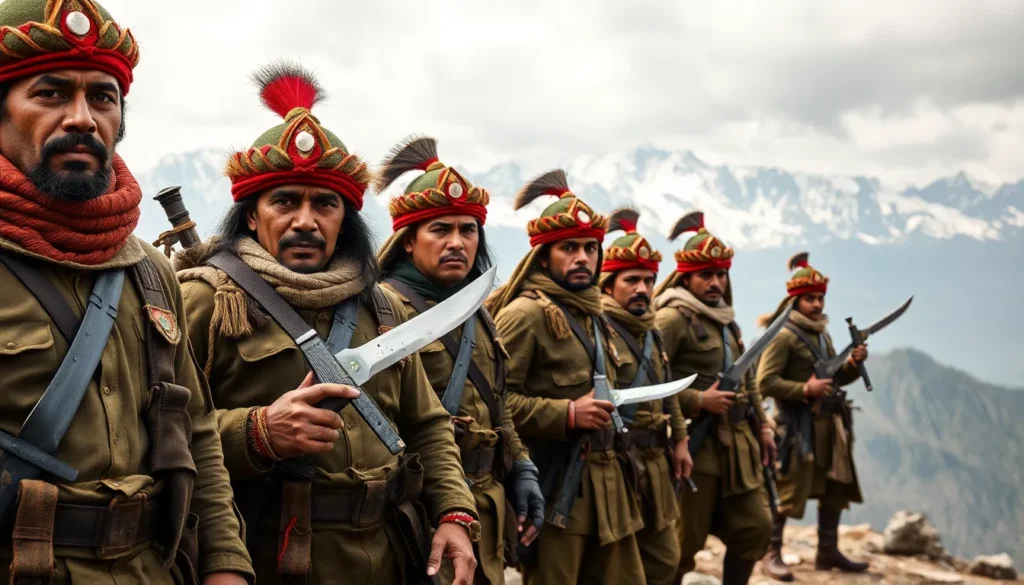In a world where adventure and excitement are just a heartbeat away, few things capture the imagination quite like the legendary Nepalkrigare. These fierce warriors, steeped in history and mystique, embody the spirit of bravery and resilience. With tales of epic battles and unyielding loyalty, they’ve become symbols of strength that resonate far beyond the borders of Nepal.
Table of Contents
ToggleOverview of Nepalkrigare
Nepalkrigare embodies a rich heritage rooted in the warrior ethos of Nepal. These soldiers hail from diverse ethnic backgrounds, each contributing unique skills and traditions. Known for elite combat capabilities, they gained a reputation through fierce battles, often serving in various military capacities both domestically and internationally.
The recruitment and training of Nepalkrigare occurs in rugged environments, fostering physical endurance and mental resilience. Rigorous exercises prepare them for combat situations that demand extraordinary strength and strategic thinking. Their discipline reflects a commitment to honor and duty, values deeply ingrained in their cultural identity.
Military history showcases Nepalkrigare’s involvement in significant conflicts. They played key roles during the Anglo-Nepalese War from 1814 to 1816, demonstrating exceptional bravery against British forces. Their valor also extended to notable campaigns within India and various peacekeeping missions globally, where they earned recognition for their effectiveness and tenacity.
Cultural representations further amplify their legendary status. Folk tales and songs immortalize the bravery of these warriors, emphasizing loyalty and sacrifice through vibrant storytelling. Their contributions resonate beyond the battlefield, enhancing Nepal’s national pride and creating a deep-seated respect among communities.
Nepalkrigare’s legacy continues to inspire new generations, ensuring that the spirit of resilience and bravery remains alive. Authentic celebrations and memorials honor their sacrifices, reinforcing the bond between the warrior class and Nepalese society at large. The influence of these courageous fighters persists, shaping the narrative of honor and valor throughout the region.
Historical Context

The rich history of the Nepalkrigare intertwines deeply with Nepal’s tumultuous past. Their legacy emerges prominently in the backdrop of significant conflicts, shaping their identity as elite warriors.
Background of the Nepali Civil War
The Nepali Civil War, also known as the Maoist Insurgency, spanned from 1996 to 2006. Initiated by the Communist Party of Nepal (Maoist), the conflict aimed to dismantle the monarchy and establish a people’s republic. During this decade-long struggle, approximately 17,000 lives were lost, and many were displaced. Nepalkrigare played crucial roles in various capacities, with members serving in security forces, protecting civilians, and maintaining order amidst chaos. The war not only altered the political landscape but also highlighted the resilience of the Nepali people, including those who took up arms for their beliefs.
Key Players and Factions
The conflict involved multiple factions, each representing differing ideologies and goals. The Maoist rebels sought to overthrow the monarchy, while the state forces aimed to preserve the existing system. Various ethnic groups, political parties, and civilian militias contributed to the fragmentation of power. Notable players included the Maoist party leaders, government officials, and international observers striving for peace. Their interactions defined the dynamics of the conflict, leading to eventual negotiations and the Comprehensive Peace Accord in 2006. Understanding these players enhances the knowledge of the historical narrative surrounding Nepalkrigare and their role in shaping modern Nepal.
Impact on Society
The Nepalkrigare significantly influenced Nepalese society. Their participation in the civil conflict reshaped various social structures.
Social Changes During the Conflict
Social dynamics altered as the civil war proceeded. The conflict resulted in increased community mobilization and a stronger sense of unity among citizens. As the Nepalkrigare engaged in security roles, trust in local institutions fluctuated but often grew as they protected vulnerable groups. Women’s roles also evolved, with many actively participating in resistance efforts and community support, while traditional gender roles faced challenges. Furthermore, the conflict exposed ethnic divisions and fostered discussions on inclusion and representation in political processes.
Economic Consequences
Economic repercussions from the conflict echoed throughout society. Infrastructure damage led to disruptions in trade and commerce, affecting everyday life for many Nepalese. Agricultural productivity declined as farmers became displaced, reducing food security. Nepalkrigare recruitment strategies shifted, influencing labor patterns and mobilizing resources for military needs. The strained economy intensified poverty in rural areas, impacting overall development. Peacekeeping efforts following the civil war opened avenues for international aid, aiming to rebuild and stabilize the economy, which remains essential for long-term recovery.
Examination of Sources
Understanding the Nepalkrigare requires accessing a variety of sources that capture their essence and legacy. These sources provide unique insights into their historical significance and role in society.
Primary Sources on Nepalkrigare
Primary sources include official military documents, personal accounts from veteran Nepalkrigare, and historical records detailing significant battles. Interviews conducted with descendants also offer valuable perspectives, adding depth to the understanding of the warriors’ impact. Archival photographs preserve visual evidence of their attire and tactics, showcasing their formidable presence. Additionally, folk tales and songs serve as cultural artifacts that highlight bravery and loyalty in Nepalkrigare narratives. Researchers can explore these primary sources for accurate depictions of their contributions during the civil conflict and other pivotal moments in Nepalese history.
Analytical Perspectives
Analytical perspectives on the Nepalkrigare emerge from scholarly articles, historical analyses, and sociopolitical studies. Expert authors provide contextual frameworks for understanding their military strategies and cultural significance. Analysis of the Nepali Civil War illuminates how their roles in security forces influenced public trust in local institutions. Sociologists examine the impact of the conflict on community mobilization and gender dynamics, shedding light on emerging social structures. Furthermore, regional studies assess the economic consequences and resource mobilization strategies utilized by the Nepalkrigare during and after the conflict. These perspectives contribute to a comprehensive understanding of the warriors’ lasting legacy.
Lessons Learned
Insights gained from the experiences of the Nepalkrigare reveal critical lessons applicable to future conflicts. Historical context emphasizes the importance of local knowledge in military operations. Understanding cultural dynamics fosters effective communication between security forces and communities.
Engagement with local populations can enhance trust, which proved vital during the Nepali Civil War. Recent developments illustrate that collaboration with diverse social groups strengthens resilience in turbulent situations. Addressing gender roles became crucial, especially as women actively participated in conflict dynamics and community rebuilding.
Analysis of past military strategies indicates the necessity of adaptable training methods for soldiers. Continued recruitment from varied ethnic backgrounds enriches a force’s cultural competence, allowing for better community relations. Acknowledging and addressing regional disparities helps mitigate tensions in future military engagements.
The legacy of Nepalkrigare remains a powerful testament to their bravery and resilience. Their influence extends far beyond the battlefield shaping Nepal’s history and cultural identity. As symbols of strength they continue to inspire future generations.
The experiences of the Nepalkrigare during significant conflicts highlight the importance of community engagement and adaptability in military operations. Their commitment to honor and duty reflects a deep cultural ethos that resonates with many.
As Nepal moves forward the lessons learned from the Nepalkrigare’s storied past will play a crucial role in fostering unity and resilience in the face of future challenges.





